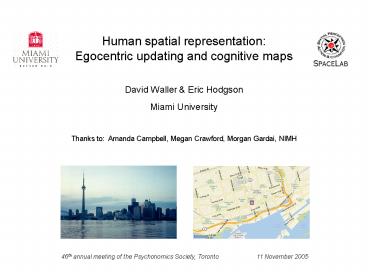Human spatial representation: PowerPoint PPT Presentation
1 / 19
Title: Human spatial representation:
1
Human spatial representation Egocentric updating
and cognitive maps
David Waller Eric Hodgson Miami University
Thanks to Amanda Campbell, Megan Crawford,
Morgan Gardai, NIMH
46th annual meeting of the Psychonomics Society,
Toronto 11 November 2005
2
How do humans mentally represent their
environment?
Egocentric updating theory
Cognitive mapping theory
Transient Dynamic Limited Perceptually
supported Egocentric
Enduring Comprehensive Supported by LTM Abstract
(e.g., allocentric)
3
Cognitive mapping and egocentric updating
theories make different predictions about the
effect of disorientation on knowledge of relative
egocentric directions Wang Spelke (2000)
4
Cognitive mapping and egocentric updating
theories make different predictions about the
effect of disorientation on knowledge of relative
egocentric directions Wang Spelke (2000)
5
Wang Spelke (2000) Experiment 2
1. Participants learn spatial layout
Table
2. Enter a booth in the center of the room
TV
3. Point with eyes open
Fabric
4. Close eyes and rotate a small amount
Chair
5. Point with eyes closed
Door
6. Rotate in place for one minute
Shelf
7. Point while disoriented
Define errors with respect to the eyes open
phase Compare variable error between eyes closed
and disoriented phases
6
Wang Spelke (2000) Experiment 2
Configuration error (o)
Variable error (o)
7
Interpreting the disorientation effect
1. Impairment of the egocentric updating system
2. Switch from an egocentric updating system to
a cognitive mapping system
Existence of two systems (Experiment 1)
Differential precision between systems
(Experiment 2)
Switch occurs readily, w/o disorientation
(Experiment 3)
Switch occurs after 90o rotation (Experiment 4)
8
Experiment 1
Existence of two systems Double dissociation
In each phase, after making egocentric pointing
estimates, participants make judgments of
relative direction
9
Experiment 1 Results Conclusions
60
Egocentric pointing task replicated Wang
Spelkes (2000) disorientation effect
50
Much smaller effect (4.5o) than they report (15o).
This effect is not well-explained by cognitive
mapping theory
40
Eyes-closed Disoriented
Judgments of relative direction are improved by
disorientation
Mean variable error (degrees)
30
Not well-explained by egocentric updating theory
20
In eyes-closed condition, knowledge of ones
current orientation interferes with task
performance
10
The double dissociation provides evidence for two
representational systems an egocentric updating
system, and a cognitive mapping system.
0
Egocentric Judgment of pointing
relative direction
10
Experiment 2
Differential precision between systems
Participants made egocentric pointing estimates
in their immediate environment and in an imagined
familiar environment
Again replicated Wang Spelkes (2000)
disorientation effect
No effect of disorientation in imagined familiar
environment
Higher variable error in all three situations in
which cognitive mapping system is used
Suggests that cognitive mapping system is
inherently less precise than egocentric updating
system
11
Experiment 3
Switch occurs readily, without disorientation
Participants rotated only 135o instead of
rotating until they were disoriented
Again replicated Wang Spelkes (2000) effect
but without disorientation
Perhaps some failures to replicate the
disorientation effect are due to participants
using the cognitive mapping system before
disorientation
12
Experiment 4
Switch does not occur before a 90o rotation
Participants rotated 0o , 45o, 90o, and 135o
after eyes-closed phase
Egocentric updating system is used over
relatively small changes in orientation
Switch to cognitive mapping system for larger
rotations
13
Conclusions
The increase in variable error in pointing as a
result of disorientation. . .
. . .is replicable but small.
. . .provides as much evidence for cognitive
mapping as for egocentric updating.
. . .is the result of a switch between
representation systems that differ in precision.
. . .does not require disorientation.
Rather than showing whether spatial information
is represented via egocentric updating or with a
cognitive map, future research will benefit from
understanding the conditions under which one type
of representation is more likely to occur
14
Thanks Amanda Campbell, Megan Crawford,
Morgan Gardai
15
(No Transcript)
16
Relationship to previous theoretical work
Several dual systems theories are broadly
consistent with the idea of a cognitive mapping
and an egocentric updating subsystems
Author(s) Systems
Creem Proffitt, 1998 Easton Sholl, 1995
Mou et al., 2004 OKeefe Nadel, 1978
Visual guidance / Explicit awareness Self-to-obje
ct / object-to-object Egocentric /
environmental Taxon / local
17
Methodological details
18
Additional results
19
Combined data in all replication conditions (n
156) (egocentric pointing to recently learned
objects in the immediate environment)
(o)
70 of the participants show the effect
30 of the participants do not show the effect

